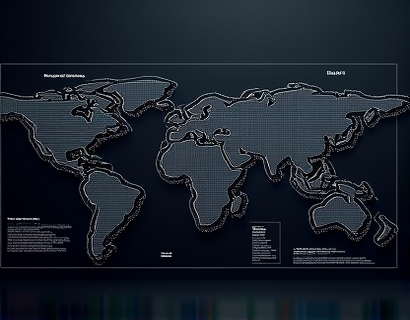Maximizing Multi-Chain Token Management: A Complete Guide for Blockchain Optimization and Performance
In the rapidly evolving world of blockchain technology, managing tokens across multiple chains effectively is crucial for maximizing performance and ensuring seamless operations. This guide is tailored for blockchain professionals and token managers who seek to optimize their token management strategies across diverse blockchains. It provides essential tools and strategies to create, track, and enhance the performance of tokens, ensuring efficient management in the dynamic crypto landscape.
Understanding Multi-Chain Token Management
Multi-chain token management involves overseeing tokens that operate on different blockchain networks. Each blockchain has its unique characteristics, consensus mechanisms, and smart contract frameworks, which can impact token functionality and performance. Understanding these differences is the first step in effective multi-chain token management.
The primary goal is to ensure that tokens can be created, transferred, and utilized seamlessly across various blockchains. This requires a deep understanding of blockchain interoperability, cross-chain communication protocols, and the technical nuances of each platform. By grasping these concepts, token managers can develop strategies to optimize token performance and maximize their utility.
Key Challenges in Multi-Chain Token Management
One of the main challenges in multi-chain token management is ensuring consistency and security across different blockchains. Each blockchain has its own set of rules and protocols, which can lead to discrepancies in token behavior. For instance, a token that is easily transferable on one chain might face restrictions on another due to different smart contract implementations or network limitations.
Another significant challenge is the management of token standards. While Ethereum's ERC-20 and ERC-721 standards are widely adopted, other blockchains may use different standards or custom implementations. This diversity requires token managers to be adaptable and knowledgeable about various token standards to ensure compatibility and interoperability.
Additionally, cross-chain transactions can introduce complexity, especially when dealing with gas fees, transaction times, and network congestion. These factors can affect the speed and cost of token transfers, impacting user experience and overall token performance. Effective management strategies must account for these variables to maintain efficiency and reliability.
Strategies for Optimizing Multi-Chain Token Performance
To overcome the challenges and optimize multi-chain token performance, several strategies can be employed. These strategies focus on enhancing token functionality, ensuring security, and improving user experience across different blockchain networks.
1. Leveraging Cross-Chain Protocols
Cross-chain protocols are essential for enabling seamless token transfers between different blockchains. Protocols like Polkadot, Cosmos, and Wrapped Token Standards (WTS) provide robust solutions for interoperability. By integrating these protocols, token managers can facilitate smooth and secure token movements, reducing friction and enhancing user experience.
For example, Polkadot's XCM (Cross-Message Channel) and XCMP (Cross-Chain Message Passing) protocols allow for efficient and secure data and asset transfers between parallel chains. Utilizing such protocols can significantly improve the performance of multi-chain tokens by ensuring fast and reliable cross-chain operations.
2. Standardizing Token Interfaces
Standardizing token interfaces across different blockchains can simplify management and enhance interoperability. Adopting widely recognized standards like ERC-20 for fungible tokens and ERC-721 for non-fungible tokens (NFTs) ensures compatibility with existing infrastructure and tools. This standardization reduces the need for custom implementations and minimizes potential bugs or security vulnerabilities.
Token managers should also consider using decentralized exchanges (DEXs) that support multiple blockchain standards. These DEXs can facilitate token swaps and liquidity provision across different chains, further enhancing the flexibility and utility of multi-chain tokens.
3. Implementing Efficient Gas Management
Gas fees are a significant cost factor in Ethereum-based token operations. To optimize performance and reduce costs, token managers can implement strategies to manage gas usage effectively. This includes optimizing smart contract code to minimize gas consumption, using layer 2 solutions like Optimism or Arbitrum, and scheduling transactions during periods of lower network congestion.
Additionally, token managers can explore alternative blockchains with more cost-effective gas pricing models. For instance, blockchains like Binance Smart Chain or Solana offer lower gas fees and higher transaction throughput, which can be advantageous for cost-sensitive token operations.
4. Enhancing Security Measures
Security is paramount in multi-chain token management. To protect tokens from theft, fraud, and other security threats, token managers should implement robust security measures. This includes conducting thorough audits of smart contracts, using trusted deployment environments, and monitoring network activity for suspicious behavior.
Implementing multi-signature wallets and cold storage solutions can also enhance security. Multi-signature wallets require multiple approvals for transactions, reducing the risk of unauthorized access. Cold storage, on the other hand, keeps private keys offline, protecting them from online threats.
5. Monitoring and Analytics
Effective monitoring and analytics are crucial for tracking token performance and identifying areas for improvement. Token managers should utilize blockchain analytics tools to monitor transaction volumes, gas prices, and network performance in real-time. These insights can help in making data-driven decisions to optimize token operations and enhance user experience.
Tools like Blockscout, TokenScan, and Dune Analytics provide comprehensive data on token metrics, network activity, and user behavior. By leveraging these tools, token managers can gain valuable insights into token performance across different blockchains and implement targeted optimizations.
Best Practices for Token Managers
To ensure successful multi-chain token management, token managers should adhere to best practices that cover various aspects of token lifecycle management, from creation to deployment and maintenance.
1. Thorough Planning and Research
Before launching a multi-chain token, thorough planning and research are essential. Token managers should conduct a comprehensive analysis of the target blockchains, considering factors such as network reliability, gas costs, and community support. Understanding the unique features and limitations of each blockchain will help in designing a token that aligns with the desired use cases and user needs.
Additionally, engaging with the blockchain communities and gathering feedback can provide valuable insights and help in refining the token's design and functionality.
2. Secure Token Deployment
Secure deployment of tokens is critical to prevent vulnerabilities and ensure trust among users. Token managers should use trusted deployment platforms and follow best practices for smart contract development. This includes writing clean, audited code, using formal verification tools, and conducting thorough testing before deployment.
It is also important to have a contingency plan in place for addressing any issues that may arise during deployment. This could involve setting up monitoring systems to detect and respond to potential security threats promptly.
3. Continuous Maintenance and Updates
Multi-chain token management requires ongoing maintenance and updates to address emerging challenges and leverage new opportunities. Token managers should regularly monitor token performance, user feedback, and changes in the blockchain ecosystem. Based on these insights, they can implement updates to improve functionality, enhance security, and adapt to evolving user needs.
Regular audits of smart contracts and network infrastructure are also essential to identify and mitigate potential risks. Keeping the token's codebase up-to-date with the latest security patches and best practices ensures long-term sustainability and reliability.
Conclusion
Maximizing multi-chain token performance is a complex but achievable goal with the right strategies and tools. By understanding the unique challenges of multi-chain management, leveraging cross-chain protocols, standardizing token interfaces, managing gas costs, and enhancing security measures, token managers can optimize their token operations across diverse blockchains.
Adhering to best practices in planning, deployment, and maintenance further ensures the long-term success and reliability of multi-chain tokens. As the blockchain landscape continues to evolve, staying informed and adaptable will be key to maintaining a competitive edge in token management.










































